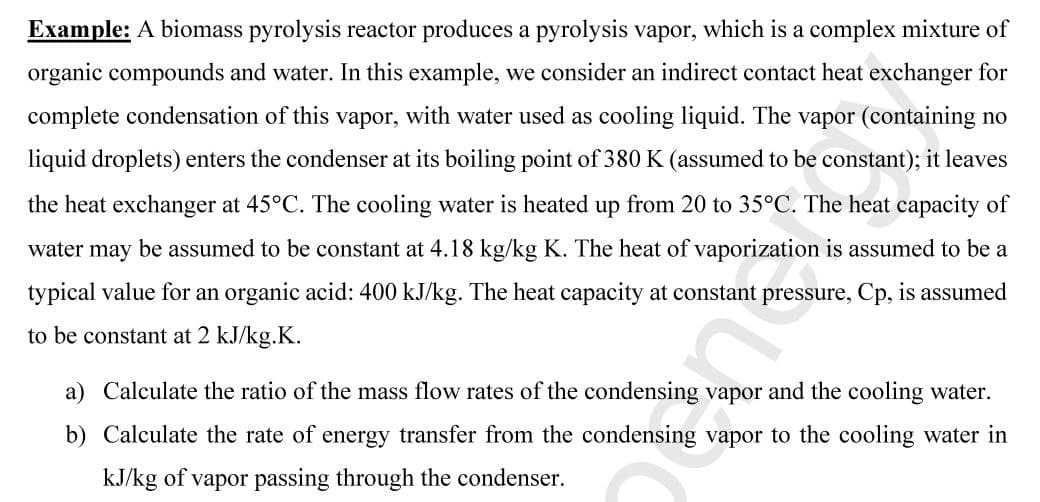Example: A biomass pyrolysis reactor produces a pyrolysis vapor, which is a complex mixture of organic compounds and water. In this example, we consider an indirect contact heat exchanger for complete condensation of this vapor, with water used as cooling liquid. The vapor (containing no liquid droplets) enters the condenser at its boiling point of 380 K (assumed to be constant); it leaves the heat exchanger at 45°C. The cooling water is heated up from 20 to 35°C. The heat capacity of water may be assumed to be constant at 4.18 kg/kg K. The heat of vaporization is assumed to be a typical value for an organic acid: 400 kJ/kg. The heat capacity at constant pressure, Cp, is assumed to be constant at 2 kJ/kg.K. a) Calculate the ratio of the mass flow rates of the condensing vapor and the cooling water. b) Calculate the rate of energy transfer from the condensing vapor to the cooling water in kJ/kg of vapor passing through the condenser.
Example: A biomass pyrolysis reactor produces a pyrolysis vapor, which is a complex mixture of organic compounds and water. In this example, we consider an indirect contact heat exchanger for complete condensation of this vapor, with water used as cooling liquid. The vapor (containing no liquid droplets) enters the condenser at its boiling point of 380 K (assumed to be constant); it leaves the heat exchanger at 45°C. The cooling water is heated up from 20 to 35°C. The heat capacity of water may be assumed to be constant at 4.18 kg/kg K. The heat of vaporization is assumed to be a typical value for an organic acid: 400 kJ/kg. The heat capacity at constant pressure, Cp, is assumed to be constant at 2 kJ/kg.K. a) Calculate the ratio of the mass flow rates of the condensing vapor and the cooling water. b) Calculate the rate of energy transfer from the condensing vapor to the cooling water in kJ/kg of vapor passing through the condenser.
Introduction to Chemical Engineering Thermodynamics
8th Edition
ISBN:9781259696527
Author:J.M. Smith Termodinamica en ingenieria quimica, Hendrick C Van Ness, Michael Abbott, Mark Swihart
Publisher:J.M. Smith Termodinamica en ingenieria quimica, Hendrick C Van Ness, Michael Abbott, Mark Swihart
Chapter1: Introduction
Section: Chapter Questions
Problem 1.1P
Related questions
Question

Transcribed Image Text:Example: A biomass pyrolysis reactor produces a pyrolysis vapor, which is a complex mixture of
organic compounds and water. In this example, we consider an indirect contact heat exchanger for
complete condensation of this vapor, with water used as cooling liquid. The vapor (containing no
liquid droplets) enters the condenser at its boiling point of 380 K (assumed to be constant); it leaves
the heat exchanger at 45°C. The cooling water is heated up from 20 to 35°C. The heat capacity of
water may be assumed to be constant at 4.18 kg/kg K. The heat of vaporization is assumed to be a
typical value for an organic acid: 400 kJ/kg. The heat capacity at constant pressure, Cp, is assumed
to be constant at 2 kJ/kg.K.
a) Calculate the ratio of the mass flow rates of the condensing vapor and the cooling water.
b) Calculate the rate of energy transfer from the condensing vapor to the cooling water in
kJ/kg of vapor passing through the condenser.
Expert Solution
This question has been solved!
Explore an expertly crafted, step-by-step solution for a thorough understanding of key concepts.
Step by step
Solved in 3 steps

Recommended textbooks for you

Introduction to Chemical Engineering Thermodynami…
Chemical Engineering
ISBN:
9781259696527
Author:
J.M. Smith Termodinamica en ingenieria quimica, Hendrick C Van Ness, Michael Abbott, Mark Swihart
Publisher:
McGraw-Hill Education

Elementary Principles of Chemical Processes, Bind…
Chemical Engineering
ISBN:
9781118431221
Author:
Richard M. Felder, Ronald W. Rousseau, Lisa G. Bullard
Publisher:
WILEY

Elements of Chemical Reaction Engineering (5th Ed…
Chemical Engineering
ISBN:
9780133887518
Author:
H. Scott Fogler
Publisher:
Prentice Hall

Introduction to Chemical Engineering Thermodynami…
Chemical Engineering
ISBN:
9781259696527
Author:
J.M. Smith Termodinamica en ingenieria quimica, Hendrick C Van Ness, Michael Abbott, Mark Swihart
Publisher:
McGraw-Hill Education

Elementary Principles of Chemical Processes, Bind…
Chemical Engineering
ISBN:
9781118431221
Author:
Richard M. Felder, Ronald W. Rousseau, Lisa G. Bullard
Publisher:
WILEY

Elements of Chemical Reaction Engineering (5th Ed…
Chemical Engineering
ISBN:
9780133887518
Author:
H. Scott Fogler
Publisher:
Prentice Hall


Industrial Plastics: Theory and Applications
Chemical Engineering
ISBN:
9781285061238
Author:
Lokensgard, Erik
Publisher:
Delmar Cengage Learning

Unit Operations of Chemical Engineering
Chemical Engineering
ISBN:
9780072848236
Author:
Warren McCabe, Julian C. Smith, Peter Harriott
Publisher:
McGraw-Hill Companies, The